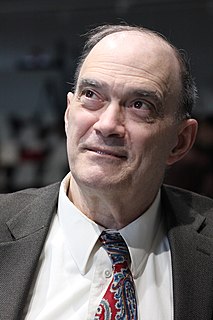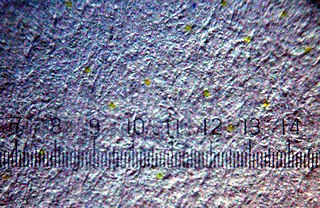
The EFF Pioneer Award is an annual prize by the Electronic Frontier Foundation (EFF) for people who have made significant contributions to the empowerment of individuals in using computers. Until 1998 it was presented at a ceremony in Washington, D.C., United States. Thereafter it was presented at the Computers, Freedom, and Privacy conference. In 2007 it was presented at the O'Reilly Emerging Technology Conference.

NSA warrantless surveillance — also commonly referred to as "warrantless-wiretapping" or "-wiretaps" — refers to the surveillance of persons within the United States, including U.S. citizens, during the collection of notionally foreign intelligence by the National Security Agency (NSA) as part of the Terrorist Surveillance Program. In late 2001, the NSA was authorized to monitor, without obtaining a FISA warrant, the phone calls, Internet activity, text messages and other communication involving any party believed by the NSA to be outside the U.S., even if the other end of the communication lay within the U.S.

Russell D. Tice is a former intelligence analyst for the United States Air Force, Office of Naval Intelligence, Defense Intelligence Agency (DIA), and National Security Agency (NSA).

Narus Inc. was a software company and vendor of big data analytics for cybersecurity.

Hepting v. AT&T is a United States class action lawsuit filed in January 2006 by the Electronic Frontier Foundation (EFF) against the telecommunications company AT&T, in which the EFF alleges that AT&T permitted and assisted the National Security Agency (NSA) in unlawfully monitoring the communications of the United States, including AT&T customers, businesses and third parties whose communications were routed through AT&T's network, as well as voice over IP telephone calls routed via the Internet.

MAINWAY is a database maintained by the United States' National Security Agency (NSA) containing metadata for hundreds of billions of telephone calls made through the four largest telephone carriers in the United States: AT&T, SBC, BellSouth and Verizon.

Room 641A is a telecommunication interception facility operated by AT&T for the U.S. National Security Agency, as part of its warrantless surveillance program as authorized by the Patriot Act. The facility commenced operations in 2003 and its purpose was publicly revealed in 2006.
The Electronic Frontier Foundation (EFF) is an international non-profit advocacy and legal organization based in the United States.
Thomas Tamm is a public defender in Washington County, Maryland. He formerly worked as an attorney in the United States Department of Justice (USDOJ) Office of Intelligence Policy and Review during 2004 when senior Justice officials responded to the warrantless NSA surveillance concerning eavesdropping on U.S. citizens. He was an anonymous whistleblower to The New York Times, making the initial disclosures which led to reporters winning Pulitzer Prizes in 2006. Although Maryland agreed to drop ethics charges against him in 2009 relating to those disclosures, and the USDOJ announced it had dropped its investigation in 2011, the D.C. Office of Bar Counsel announced in January 2016 that it had brought disciplinary charges against Tamm relating to those events. Despite some controversy with respect to politicisation of that office and similar charges being brought to silence attorney whistleblowers especially beginning in 2014, Tamm in March 2016 agreed to public censure by the District of Columbia Court of Appeals in order to allow him to proceed with his life and career.

Trailblazer was a United States National Security Agency (NSA) program intended to develop a capability to analyze data carried on communications networks like the Internet. It was intended to track entities using communication methods such as cell phones and e-mail.

Laura Poitras is an American director and producer of documentary films.

Thomas Andrews Drake is a former senior executive of the National Security Agency (NSA), a decorated United States Air Force and United States Navy veteran, and a whistleblower. In 2010, the government alleged that Drake mishandled documents, one of the few such Espionage Act cases in U.S. history. Drake's defenders claim that he was instead being persecuted for challenging the Trailblazer Project. He is the 2011 recipient of the Ridenhour Prize for Truth-Telling and co-recipient of the Sam Adams Associates for Integrity in Intelligence (SAAII) award.

The Utah Data Center (UDC), also known as the Intelligence Community Comprehensive National Cybersecurity Initiative Data Center, is a data storage facility for the United States Intelligence Community that is designed to store data estimated to be on the order of exabytes or larger. Its purpose is to support the Comprehensive National Cybersecurity Initiative (CNCI), though its precise mission is classified. The National Security Agency (NSA) leads operations at the facility as the executive agent for the Director of National Intelligence. It is located at Camp Williams near Bluffdale, Utah, between Utah Lake and Great Salt Lake and was completed in May 2014 at a cost of $1.5 billion.

Jewel v. National Security Agency is a United States class action lawsuit filed by the Electronic Frontier Foundation (EFF) against the National Security Agency (NSA) and several high-ranking officials in the administration of 43rd U.S. president George W. Bush, charging an "illegal and unconstitutional program of dragnet communications surveillance".

William Edward Binney is a former intelligence official with the United States National Security Agency (NSA) and whistleblower. He retired on October 31, 2001, after more than 30 years with the agency.

Perry Fellwock is a former National Security Agency (NSA) analyst and whistleblower who revealed the existence of the NSA and its worldwide covert surveillance network in an interview, using the pseudonym Winslow Peck, with Ramparts in 1971. At the time that Fellwock blew the whistle on ECHELON, the NSA was a nearly unknown organization and among the most secretive of the US intelligence agencies. Fellwock revealed that it had a significantly larger budget than the Central Intelligence Agency (CIA). Fellwock was motivated by Daniel Ellsberg's release of the Pentagon Papers. Today, Fellwock has been acknowledged as the first NSA whistleblower.

The practice of mass surveillance in the United States dates back to wartime monitoring and censorship of international communications from, to, or which passed through the United States. After the First and Second World Wars, mass surveillance continued throughout the Cold War period, via programs such as the Black Chamber and Project SHAMROCK. The formation and growth of federal law-enforcement and intelligence agencies such as the FBI, CIA, and NSA institutionalized surveillance used to also silence political dissent, as evidenced by COINTELPRO projects which targeted various organizations and individuals. During the Civil Rights Movement era, many individuals put under surveillance orders were first labelled as integrationists, then deemed subversive, and sometimes suspected to be supportive of the communist model of the United States' rival at the time, the Soviet Union. Other targeted individuals and groups included Native American activists, African American and Chicano liberation movement activists, and anti-war protesters.

Global surveillance refers to the practice of globalized mass surveillance on entire populations across national borders. Although its existence was first revealed in the 1970s and led legislators to attempt to curb domestic spying by the National Security Agency (NSA), it did not receive sustained public attention until the existence of ECHELON was revealed in the 1980s and confirmed in the 1990s. In 2013 it gained substantial worldwide media attention due to the global surveillance disclosure by Edward Snowden.

Global surveillance whistleblowers are whistleblowers who provided public knowledge of global surveillance.

A Machine Identification Code (MIC), also known as printer steganography, yellow dots, tracking dots or secret dots, is a digital watermark which certain color laser printers and copiers leave on every printed page, allowing identification of the device which was used to print a document and giving clues to the originator. Developed by Xerox and Canon in the mid-1980s, its existence became public only in 2004. In 2018, scientists developed privacy software to anonymize prints in order to support whistleblowers publishing their work.
















